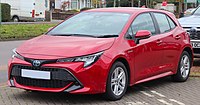
Photo from wikipedia
Abstract The aim of this paper is to estimate fuel demand behaviour related to car use by households with different income levels in Spain using micro-level panel data in order… Click to show full abstract
Abstract The aim of this paper is to estimate fuel demand behaviour related to car use by households with different income levels in Spain using micro-level panel data in order to infer public policy implications. Our results show that the income elasticity of fuel demand is highest for the lowest income group and diminishes monotonically for the others. The price elasticity is highest in absolute value for the lowest income group, lowest for the highest income quartile and similar for the medium-low and medium-high income groups. Finally, the lowest income group is the most responsive to changes in the price of public transport, whereas the medium-low income group is the least responsive. This suggests that pricing policies aiming to reduce car fuel consumption would have different distributive impacts. Thus, the two main pricing transport policies, fuel taxes and public transport subsidies, are deemed complementary and their combination could be defended on distributional grounds.
Journal Title: Case studies on transport policy
Year Published: 2017
Link to full text (if available)
Share on Social Media: Sign Up to like & get
recommendations!